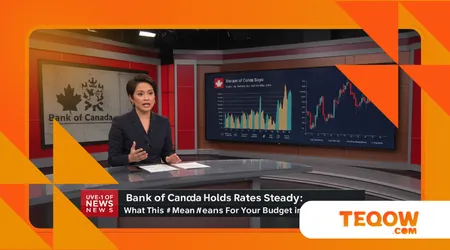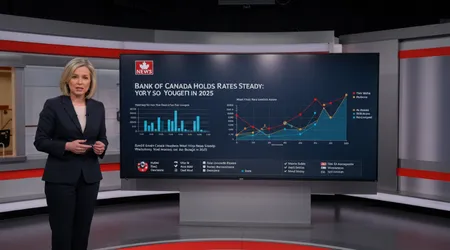Bank of Canada Holds Rates Steady: What This Means for Your Budget in 2025

The Bank of Canada holds rates steady at 2.75%, a decision announced on April 16, 2025, halting seven consecutive cuts since June 2024.
This pause, driven by U.S. trade policy uncertainty, signals caution amid global economic turbulence. For Canadians, this impacts mortgages, savings, and daily budgets in 2025.
Governor Tiff Macklem emphasized the need for clarity on tariffs, which could disrupt growth and inflation.
This article unpacks what this means for your finances, offering practical insights and strategies to navigate the uncertainty.
Why does this matter? Because your budget is a living, breathing plan that must adapt to these shifts.
Economic decisions like this ripple through households, affecting everything from grocery bills to homeownership dreams.
With inflation cooling to 2.3% in March 2025, per Statistics Canada, the central bank’s choice reflects a delicate balance.
This piece explores the implications, provides actionable advice, and equips you to make informed financial choices in a volatile year.
Why the Bank of Canada Hit Pause
Global trade uncertainty, particularly U.S. tariffs, prompted the Bank of Canada holds rates steady decision. Macklem cited “erratic” U.S. trade policies as a key factor.
These policies, including proposed tariffs, could dampen Canada’s growth, with GDP projected at 1.8% for Q1 2025.
The central bank is waiting to assess the economic fallout. Inflation, though lower, remains a concern, with short-term expectations rising due to trade tensions.
This pause marks a shift from aggressive rate cuts, reflecting caution. Domestic demand is expected to stagnate, with business investment and household spending slowing.
++ Federal Investments Ignite Ontario’s AI Revolution
The Bank of Canada holds rates steady to avoid premature moves that could destabilize markets.
For consumers, this means borrowing costs won’t drop soon, affecting big-ticket purchases like homes or cars.
The decision also stems from mixed signals. While inflation eased, trade disruptions could push prices higher, complicating monetary policy.
By holding rates, the Bank of Canada holds rates steady aims to stabilize expectations. Canadians must now plan for sustained borrowing costs and potential price pressures in 2025.

Impact on Your Borrowing and Debt
Mortgage holders face unchanged borrowing costs as the Bank of Canada holds rates steady. Variable-rate mortgage payments won’t see relief, with rates tied to the 2.75% benchmark.
For example, Sarah, a Toronto homeowner, hoped for lower payments but now faces steady $2,500 monthly costs.
Fixed-rate mortgages, influenced by bond yields, may rise if trade tensions increase market volatility.
Credit card and line-of-credit users should brace for high interest rates. With no rate cuts, carrying balances remains costly 19% APR on average.
Also read: Small Business Strategies for Navigating Tariffs and Trade Barriers in 2025
Paying down debt is critical. John, a Vancouver freelancer, consolidated his $10,000 credit card debt to a lower-rate loan, saving $200 monthly.
Personal loans and auto financing also feel the pinch. Lenders, anticipating prolonged high rates, are less likely to offer discounts.
The Bank of Canada holds rates steady means budgeting for debt repayment is non-negotiable. Prioritize high-interest debt to free up cash flow for 2025’s uncertainties.
Savings and Investments: Opportunities and Risks
Savers benefit slightly as the Bank of Canada holds rates steady, keeping high-interest savings account yields stable at 3-4%. GICs, offering 4% for five-year terms, remain attractive.
However, inflation at 2.3% erodes real returns, so locking in longer terms makes sense. For instance, a $10,000 GIC at 4% yields $400 annually, outpacing inflation.
Stock markets, rattled by trade war fears, face volatility. The TSX dropped 2% post-announcement, reflecting uncertainty.
Read more: The Impact of Lower Borrowing Costs on Real Estate Investment in 2025
Diversifying into stable sectors like utilities or consumer staples can mitigate risks. Bonds, meanwhile, offer modest returns but are sensitive to tariff-driven yield spikes.
Retirement planning requires caution. With the Bank of Canada holds rates steady, RRSP contributions should prioritize low-fee, diversified funds.
Younger investors, like 30-year-old Priya, can lean into equities for long-term growth, while retirees should favor fixed-income assets to preserve capital in 2025.
Household Budgeting in an Uncertain Economy
Rising costs loom as trade tariffs threaten to increase prices for imported goods. The Bank of Canada holds rates steady amplifies this risk, with inflation potentially climbing.
Groceries, already up 3% year-over-year, could strain budgets further. A family of four spending $1,200 monthly on food may need to cut discretionary spending.
Energy costs, tied to global markets, are another concern. Natural gas prices, impacted by trade disruptions, may rise, hitting heating bills.
Budgeting apps like YNAB can help track expenses and identify savings, ensuring resilience against price shocks.
Job market uncertainty, with unemployment projected to hit 8% per BMO’s forecast, demands a financial buffer.
The Bank of Canada holds rates steady underscores the need for an emergency fund—three to six months’ expenses.
Freelancers, like John, should diversify income streams to weather potential slowdowns.
Housing Market: Buyers and Sellers Take Note
The housing market, already cooling, faces headwinds as the Bank of Canada holds rates steady. Higher borrowing costs deter buyers, slowing demand.
Toronto’s average home price, $1.1 million, remains out of reach for many. First-time buyers like Priya may delay purchases, opting to save for larger down payments.
Sellers face longer listing times and softer prices. In Vancouver, homes are taking 45 days to sell, up from 30 in 2024.
Staging and competitive pricing are key to attracting buyers. Renters, meanwhile, see no relief, with Toronto rents averaging $2,800 for a one-bedroom.
Investors in real estate must tread carefully. With rates unchanged, rental property yields are squeezed by high mortgage costs.
The Bank of Canada holds rates steady suggests a wait-and-see approach for major housing decisions in 2025.
Strategies to Thrive in 2025
Proactive financial planning is your lifeline. Start by reviewing your budget cut subscriptions or dine out less to save $100 monthly.
Next, tackle high-interest debt; even $50 extra payments reduce long-term costs. Savings should be parked in high-yield accounts or GICs for modest growth.
Diversify investments to hedge against market swings. A balanced portfolio with 60% equities and 40% bonds suits most risk profiles.
For career stability, upskill through platforms like Coursera to stay competitive in a softening job market.
Finally, stay informed. Monitor Bank of Canada announcements and global trade developments.
The Bank of Canada holds rates steady is a signal to act, not react. Build flexibility into your finances, like a ship adjusting sails to navigate stormy seas.
Supporting Data
| Category | Impact of Rate Hold | Actionable Tip |
|---|---|---|
| Mortgage Rates | Variable rates stable at ~5%; fixed rates may rise | Lock in fixed rates if renewing soon |
| Savings Accounts | Yields steady at 3-4% | Choose high-interest accounts or GICs |
| Inflation | 2.3% in March 2025, may rise with tariffs | Budget for 3-5% grocery price increases |
| Unemployment | Projected at 8% by BMO | Build emergency fund, upskill for job security |
Looking Ahead: What’s Next for Rates?
Economists, like National Bank’s Warren Lovely, predict further cuts in 2025 if trade tensions ease.
The Bank of Canada holds rates steady now, but June’s meeting could bring a 25-basis-point cut, per market pricing.
Inflation trends and U.S. policy will dictate the pace. Canadians should prepare for both scenarios stagnation or relief.
The central bank’s focus on flexibility means households must mirror this approach. Scenario planning, like Macklem’s tariff models, can guide budgeting.
If tariffs are negotiated away, inflation may dip below 2%, easing pressure. If not, expect tighter budgets.
Global factors, like China’s slowing economy or eurozone weakness, add complexity. Staying agile whether through side hustles or conservative investments positions you to adapt.
The Bank of Canada holds rates steady, but your financial strategy shouldn’t.
Conclusion: Take Control of Your Finances
The Bank of Canada holds rates steady, casting a spotlight on your financial resilience. This isn’t just a policy pause it’s a wake-up call to reassess your budget, debt, and investments.
With trade wars looming and inflation risks rising, proactive steps are non-negotiable. From trimming expenses to diversifying income, small actions compound into big wins.
Statistics Canada’s 2.3% inflation rate reminds us: prices won’t wait for your plan.
Think of your budget like a garden neglect it, and weeds choke growth; tend it, and it thrives. Canadians like Sarah and John show how adaptability pays off.
What’s your next move? Stay informed, act decisively, and build a 2025 that’s financially secure, no matter the economic weather.
Frequently Asked Questions
1. Why did the Bank of Canada hold rates steady?
The Bank of Canada holds rates steady due to U.S. trade policy uncertainty, particularly tariffs, which could raise inflation and slow growth.
2. How does this affect my mortgage?
Variable-rate mortgage payments remain unchanged, and fixed rates may rise if bond yields increase due to trade disruptions.
3. Should I invest or save in 2025?
Balance both: save in high-yield accounts or GICs (3-4% returns) and invest in diversified funds to hedge market volatility.
4. What if tariffs cause a recession?
A recession could prompt rate cuts, but higher inflation might delay them. Build an emergency fund and diversify income.
5. How can I prepare my budget?
Track expenses with apps, cut non-essentials, and save 3-6 months’ expenses to cushion against price hikes or job losses.
